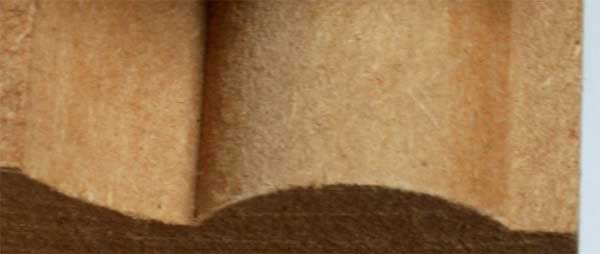5.4m MDF Range
Our standard range of MDF Skirting Boards comes in 5.4m double primed and sanded lengths for a super smooth finish. We have a limited range of profiles and heights in stock for a rapid 48 hour dispatch.


Available in lots of profiles:
Always in stock:
- Ogee MDF Skirting Boards
- Torus MDF Skirting Boards
- Ovolo MDF Skirting Boards
- Lambs Tongue MDF Skirting Boards
- Bullnose MDF Skirting Boards
- Square Edge MDF Skirting Boards
Call to check stock:
- Ogee2 MDF Skirting Boards
- Georgian MDF Skirting Boards
- Victorian MDF Skirting Boards
- Edge2 MDF Skirting Boards
- Jazz MDF Skirting Boards
- Jazz2 MDF Skirting Boards
- Modern2 MDF Skirting Boards
- Mini Steps MDF Skiting Boards
- Stepped MDF Skirting Boards
- Colonial MDF Skirting Boards
- Many others and custom profiles MDF Skirting Boards
Heights include: 44mm, 57mm, 68mm, 94mm, 119mm, 144mm, 168mm, 194mm, 219mm
There is no minimum order on stock items, however a minimum order may apply if the item isn’t currently in stock. In some cases 3m lengths are a cheaper alternative.
Not all stock profiles are available in all heights. Please call for confirmation.
Premium MDF Range
Anything is possible in our premium range, any height, any thickness, any profile. You name it, we can make it.
Available in any of the profiles below, as well as bespoke profiles – rapid manufacture and dispatch.
Literally unlimited options so you can have exactly what you’re looking for.
- Choose the mdf skirting profile you like
- Choose the height of your mdf skirting
- Choose the thickness of your mdf skirting
- Place your order on the phone
- Receive your goods in the fastest time of any bespoke skirting manufacturer.
We can make anything you like, literally any mdf skirting boards you can imagine.
Here’s a video to show how we make our skirting boards, from start to finish.

We take great care in the manufacture of our mdf skirting boards and are able to dispatch boards faster than any competitor. We also use only the best materials, unlike many of our competitors, who choose to sell you cheap rubbish just to take your money.
Quality materials and a quality manufacturing process means you will have the highest quality of finish possible.
Why use MDF for Skirting?
When producing MDF skirting boards, there are several methods of production they go through for machining, finishing and profiling. The MDF has a compressed and smooth surface making the skirting easy to paint and finish afterwards giving a long life to your skirting boards. We produce some skirting boards from MDF in bulk using a high-tech moulder which produces hundreds of metres of mdf skirting every minute, in a given profile. The machine will then prime, sand, and reprime the mdf skirting boards so that it is finished with a semi-finished surface which at most will require a final coat of paint. Our other method for producing mdf skirting allows us to produce a much fuller range of skirting boards from MDF, as we produce our own cutting tools for profiling the skirting, and then put them through a specially equipped spindle moulder to create the mould we are making. The priming for these boards is usually hand-sprayed and will therefore require a light sanding before a final coat is applied. This has the added bonus of protecting the mdf skirting from moisture until the sanding and final coat are applied for finishing and fixing the skirting boards to the wall.
MDF Skirting Boards have been used for many, many years due to their durable nature. You will find MDF used for skirting in a large number of houses around the UK and indeed around the world. MDF is an environmentally friendly material because it does not depend upon single strips of wood, and can be easily manipulated into various forms and structures for construction. You will also see MDF being used for window boards to match the skirting boards and architrave. You may also find skirting blocks are made from MDF as their nature lends very well to mitre the skirting boards against the skirting blocks.
Lengths of MDF
It is not so commonly known what lengths mdf skirting boards are available in. In fact, the limits on our mdf skirting boards are made only due to the machinery that are used to create and mould the skirting as described earlier. We can produce 2.4 or 3m skirting boards in any profile required, even if that profile has been newly created by the customer. This is because when we create a new tool as can be seen on our skirting boards video page on youtube, we then fit the spindle moulder with the cutting tool and produce the skirting boards out of pre-cut strips of MDF at whatever height is required by the order. This also allows for flexibility of the height of the skirting boards.
When a customer requires a highly economical batch of skirting boards, not only do we also recommend MDF to be used for this skirting, but also we are able to do the full order on one of our bulk production runs for the skirting on a high speed moulder. This has many advantages such as;
- Longer lengths – 5.4m lengths MDF rather than 2.4 / 3m
- Higher quality finish as the process includes a mid-way sanding and recoat of primer bringing the finish to an almost finished quality
- Economical production runs – as you can imagine this process makes the whole manufacturing process for MDF skirting much quicker, cheaper and overall, more economically and environmentally friendly
Therefore when a customer requires a large construction to be fitted out with skirting boards, we recommend that 5.4m long lengths of mdf skirting boards are used.
Mitering awkward profiles
You may think that when you have a very elaborate skirting profile that it will be difficult to mitre. However, our profiling is so accurate that even if you have a very fancy designed skirting board, and have a perfect 45 degree mitre, the mdf boards will come together perfectly and each parallel of the boards will line up perfectly to produce a very professional and attractive finish.
Oak Veneered MDF
One of the most modern ways of making your mdf skirting look even better is to use our fantastic oak veneered processes. We are now able to use a real, thin slice of oak to wrap around the mdf board, and therefore produce a board that looks very much like oak from a distance, and can even be lacquered and finished in any way you choose! Our oak veneered mdf skirting boards are available in 4.4m lengths so it is also a very good middle point between short and long lengths, and is also very economical indeed. We have carried out surveys among customers to choose between two boards to determine which one is the oak skirting board, and which one is mdf skirting veneered with oak. Unless the customer actually gets close enough to touch and properly inspect the mdf skirting, they are unable to decide which one is the real thing. Once lacquered, this process is even more difficult because the lacquer gives the MDF – in – disguise such a fantastic finish that your friends will be easily fooled into believing that you have just installed expensive oak skirting boards, all under the guise of mdf skirting.
Mdf skirting boards are in fact large versions of architrave. People often think that the two are mutually exclusive, however we have had customers use what we would consider as 4inch skirting as their architrave because they have a large house with high ceilings and therefore large architrave and large skirting are a must have requirement for this to look right. The most common requests for mdf skirting would be 4 inch (100mm) skirting, 5 inch (125mm) skirting, 6 inch (150mm) skirting and in some cases as high as 9 inch (225mm)skirting or even 12 inch (300mm) skirting. These are cases that we can cope with equally because all of our skirting is produced according to our customer needs. We have decided that the customers requirement is at the front of our skirting production methods and therefore each skirting board can be customized from mdf in any fashion required.
MDF Depth / Thickness
MDF is of course available in various thicknesses, or depth as some have come to refer. The most common thickness for mdf used today, and in fact the thickness that we used for our skirting boards will be 18mm. We do frequently however have requests, and fulfill those requests for mdf skirting to be made from 25mm mdf, or 15mm mdf for example. Both of which are still great for producing mdf skirting boards and architrave.
MDF Skirting Boards
MDF Skirting Boards are the best value choice if you are going to paint your skirting boards white. A hardwood skirting board will be more durable than MDF, but hardwoods become expensive very quickly.
MDF is made up of compressed fibres, it’s a man made material that is cheap and durable. MDF Skirting Boards can be moulded with any profile you’d like, but its worth knowing that furring may occur. Furring comes as a result of the way MDF skirting boards are manufactured, or specifically the way MDF is formed. You see, the front and back surfaces of the MDF boards are harder than the centre. When you cut into the centre of the boards the fibres are longer and don’t cut as cleanly.
But don’t let a little bit of furring put you off MDF Skirting Boards – A quick rub down with some sand paper easily solves the problem.
Fitting MDF Skirting
When it comes to mounting MDF Skirting boards you’ve got a few options – The quickest and easiest is with some glue in a tube. A few dots of glue along regular intervals will easily hold your MDF skirting boards onto the wall for the foreseeable future. If you’d prefer to attach the mdf skirting boards more solidly, combine the glue with screws. Please note you can only screw MDF skirting boards front to back, and on an un-profiled section of the skirting. It also helps to pre-drill the holes.
If you don’t follow the above guidelines for mounting MDF Skirting Boards, they will split and crack. In some senses MDF is a difficult material to work with, so its important your MDF skirting boards are mounted by somebody that knows how to deal with the material, but don’t let this deter you. Simply gluing the MDF skirting boards onto the wall is more than sufficient.
Nails aren’t a good idea – you may as well just take a chisel to your mdf skirting boards, as it will split and crack any and everywhere. If you pre-drill a hole the exact width of the nails with the intention of nailing into a wall you may get away with it, but for the sake of buying a few screws we don’t think you should risk it.
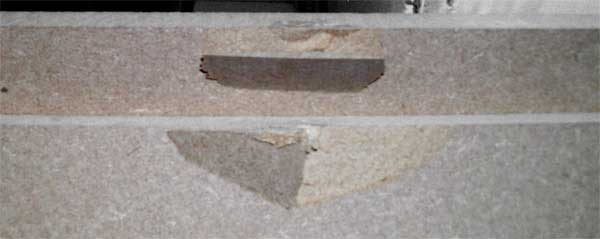
Water and MDF
Water is another thing to try and avoid. This sounds like common sense because water will damage any board you are trying to mount onto your wall. In most cases MDF skirting boards are less prone to damage by water because they only swell up, rather than bend and warp like hardwoods. Once your hardwood is bent, you will be hard pressed to rectify the problem. MDF will simply dry out, it may remain slightly deformed but shouldn’t be noticeable.
Don’t bend your MDF skirting boards if you can help it. We’ve seen 5.4m MDF Skirting boards jammed into a 4 metre long van, and you can guess the outcome. We absolutely do not condone the bending of MDF skirting boards, and we take utmost care when selecting carriers to ensure they don’t bend your MDF skirting boards. They can actually take a fair bit of abuse, but once they start to crack you’ve lost them.

MDF Quality
MDF skirting boards come in a few different qualities – basically the harder the mdf, and the finer the fibrous material, the higher the quality. It seems reasonable and obvious that harder MDF is preferable, especially when your using it to make what turn out to be essentially kick boards, but the granularity of the fibres is less intuitive.
The reason smaller fibres in mdf makes for better skirting boards is because the mdf is moulded to shape a profile. As mentioned above when you cut into MDF you often aren’t able to just cut through the individual fibres and instead you split them apart from one another, so this produces a furring on the moulded surfaces. This furring is much more profound with lower quality MDF.
Priming of MDF
Another option to consider when buying MDF skirting boards is if you want primed mdf skirting boards, or un-primed. Be aware that the result of a single primer coat (which is what we sell as standard) will still need to be sanded and re-primed before painting. You can order a second layer of priming for your MDF skirting boards for an extra charge, in which case we will sand them and add the second coat of primer for you. The first coat of primer will always soak into the surface of the MDF, especially where the skirting boards have been moulded and profiled.
MDF Skirting Profiles
As we’ve spoken about MDF skirting board profiles many times, we’d like to exhibit some of the most popular MDF skirting board profiles as well as the more modern and unique profiles.
The single most popular in the UK is the torus mdf skirting boards – Torus seems to appear in 90% of English homes. But the fashion is shifting away from this stock standard option towards something more unique. Torus is quite a chunky rounded profile which is very simple, but gives your walls a little bit of character. One of the other most popular options is bullnose mdf skirting boards, which are also known as pencil round. As the name suggests these just feature a rounded edge with no other detail. They are easy to keep clean and don’t attract any attention.
Two of the other popular mouldings are ovolo mdf skirting boards, and ogee mdf skirting boards. They are very different in style from one another, one being more elaborate than torus skirting, and the other leaning towards the practicality of bullnose skirting with a little bit more character.
Ogee skirting has a more delicate patterning than the big chunky round torus skirting, and gives a more Victorian classic look. Ovolo is very simple profile which is easy to clean, with a smooth sloped surface and only a couple of small ridges which may collect a tiny amount of dust, but with the way Ovolo skirting is shaped you can easily run a dust cloth or mop along the wall and quickly brush any dust off.

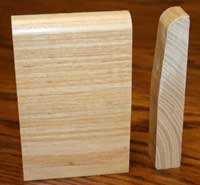
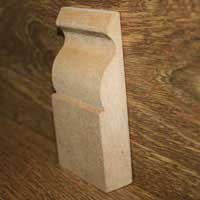
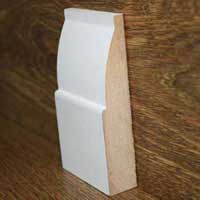
From left to right: Torus, Bullnose, Ogee, Ovolo



